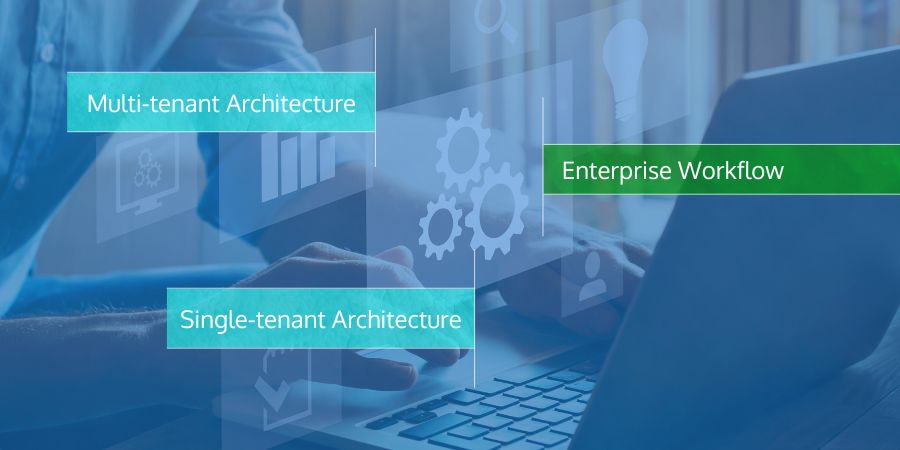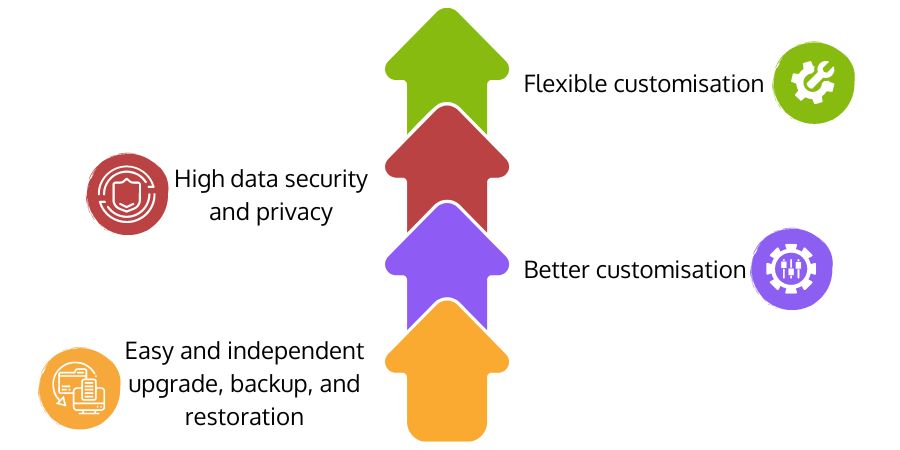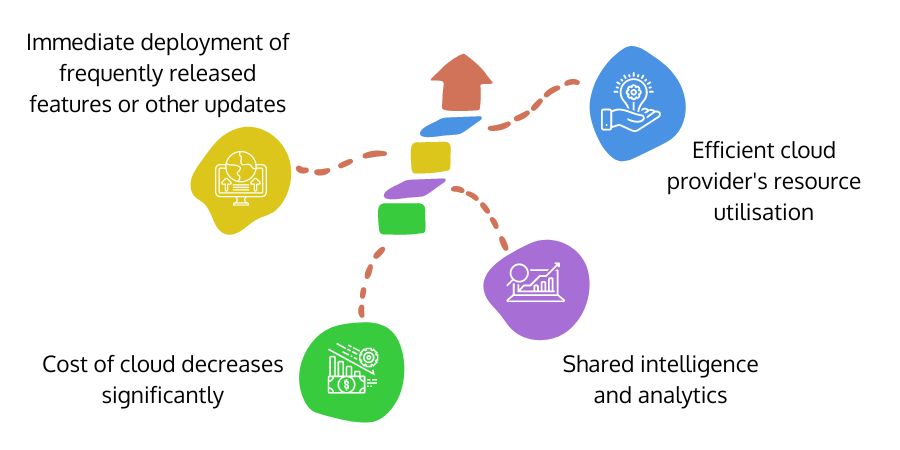
Introduction
In the early days, enterprises hesitated to adopt cloud-based services for security reasons and non-reliability. But soon, enterprises started to transform digitally because all cloud service providers have come up with price variations and security that make cloud services much more reliable. Cloud computing comes in a wide array of flavours: public, private, hybrid, etc. It also brings the concept of tenants, wherein various organisations can either share the cloud infrastructure or use them as a dedicated infrastructure. There are two different types of cloud architecture based on the tenants. Enterprises choose them as per their requirements. This article will discuss single-tenant and multi-tenant architecture and how both cater to unique benefits. Also, we will understand the scenarios when and which proves to be the best.
What are Tenants in Cloud Computing?
Tenants are a group of companies, users, or customers who share common access or a specific type of access with distinct privileges to the hardware or software instances. Cloud computing comes with two different types of tenants. These are:
- Single-tenant
- Multi-tenant
Let's discuss each of them separately with their benefits and challenges.
Single Tenant Architecture
Single Tenant Architecture is cloud architecture in which only a single customer gets served with a single software instance and its supporting infrastructure. Enterprises use single-tenant architecture in dedicated cloud service delivery or the software-as-a-service (SaaS) delivery model to keep the software secure and work at an expected speed. Thus, all customer data and interactions get kept distinct from other customers in a single-tenant system. Moreover, customer information isn't stored in the same database and isn't shared. In such architecture, the tenants get the maximum flexibility to modify the infrastructure and software instance. Enterprises prefer to go with single tenancy because of the in-depth control, flexibility, reliability, and security measures. A single-tenant architecture also enables automated remote backup, allowing tenants to restore their data if enterprises encounter a disaster or data loss situation.

Benefits of Single Tenant Architecture
Single-tenant architecture is costly and less expected to opt for than multi-tenant architecture. But enterprises with strict compliance and policies or who want to cater to seamless auditing can take single-tenant architecture. Let us explore some advantages enterprises can extract by leveraging single-tenant cloud architecture.
- Flexible Customisation: Enterprises prefer using single-tenant architecture because of the easy customisation feature. Most SaaS-based services and application running requires periodic customisation & gets managed by the service provider team. Also, the cloud service provider can provide dedicated access to cloud servers wherein enterprises can easily manage and dynamically scale new cloud services as per requirement.
- High Data Security and Privacy: Within the same cloud provider, a single tenancy architecture provides separate application instances, dedicated hardware, and supporting elements like databases, dependencies, etc., separately for each tenant/customer. Therefore, users outside your organisation cannot gain access or cannot even track your data accessibility. It reduces the chance of cyber threats and data breaches. Since no other tenants have cloud infrastructure or hardware access, data privacy remains intact, maintaining all compliance. Again, if any user/enterprise within the same cloud provider experiences a data breach or malicious attack, other tenants do not get affected because of the attack.
- Better Customisation: Cloud providers can manage miscellaneous service updates in different models. The cloud provider enables the companies to do so. With single-tenant architecture, enterprises get the benefits of managing dedicated cloud access and other features within the rented infrastructure, like storage, server logs, computing power, and security policies.
- Easy and Independent Upgrade, Backup, and Restoration: Since the single-tenant cloud architecture has no connection to other tenants of the cloud provider, it becomes easy to deal with different types of cloud backups. Also, customers can easily set different mechanisms and privileges to restore the data. Customers have flexible and agile controls over system upgrades besides data backup and restoration.
Shortcomings of Single-tenant Architecture
Despite the significant benefits of a single tenancy, it is the least popular cloud architecture among its various competing options. Here are some of the shortcomings of single-tenant architecture.
- Excess Cost: Renting a single-tenant cloud is massive compared to a multi-tenant one because the cloud service provider dedicates a cloud segment (having a single software instance, database, and supporting infrastructure) or server to a single enterprise or customer. Such explicit service becomes very expensive for startups or mid-range companies with low or average annual revenue. Furthermore, hosting one SaaS instance per customer raises costs because it requires exclusive setup time, customisation, resources, and maintenance.
- Cloud Provider Update Deployment Takes Time: Releasing customer-specific updates, or security patches gets deployed to the multi-tenant architecture rather than single-tenant architecture. Because single-tenant architecture has an isolated cloud environment, cloud providers focus on deploying their updates to multi-tenants.
Multi-tenant Architecture in Cloud Computing
Such cloud architecture renders a different operational model and utilises various techniques to reduce cost. The cloud service provider does not reserve cloud processing, storage, or other segments to a single customer, enterprise, or tenant. Instead, the software instance serves different tenants or enterprises within the same cloud ecosystem. The cloud provider delivers similar services (security updates, auto-management, dashboard support, etc.) to all its tenants. Since a one-size-fits-all approach runs on multiple customers, the overall cloud cost reduces. But the cloud providers permit different customers to employ different personal databases and other associated infrastructure, such as computation and isolated storage. Also, in this cloud architecture, one tenant's data will not get visible to other tenants. Since all the tenants use the same software instances, cloud servers, and databases, the entire cloud ecosystem is predisposed to security threats & increases the chances of data leakage - in case any vulnerability creeps in. All top-level cloud providers like Microsoft Azure, Google Cloud, Amazon Web Services, etc., provide multi-tenant architecture.

Benefits of Multi-tenant Architecture
Since multiple customers leverage the cloud's software instance, multi-tenant architecture's cost went down significantly & helps in the rapid deployment of apps and services. Here is a list of some beneficial sides that a multi-tenant architecture renders to enterprises that opt for this cloud architecture.
- Immediate Deployment of Frequently Released Features or Other Updates : All those enterprises and customers leveraging the multi-tenant cloud architecture under one hood get the entire feature and patch updates. That is when; this cloud architecture becomes beneficial to customers as they require less technical support and in-house IT professionals to manage the corporate functions. Thus, multi-tenancy became the heart of all SaaS-based services for deploying cloud-based applications & updates quickly with minimal or no effort.
- Cost of Cloud Decreases Significantly: In a multi-tenant architecture, the cloud performance and other infrastructure are split into many tenants. Each customer has to pay less in multi-tenant compared to single-tenant. Thus, the overall cost for all tenants gets reduced.
- Efficient Cloud Provider's Resource Utilisation: In single-tenant architecture, cloud resources like storage, features, and computational power get wasted due to underutilisation. But in the case of multi-tenant architecture, resources get utilised to their maximum potential because multiple tenants employ the complete cloud infrastructure and computational power.Companies with numerous branches and acquired firms or multiple ventures under one parent company prefer this cloud architecture for optimum utilisation at a lesser cost.
- Shared Intelligence and Analytics: Since the cloud vendor delivers influential visual intelligence & analytics in a multi-tenant architecture, it becomes easy for customers to visualise cloud utilisation analytics through dashboards and reports. Also, any multi-tenant cloud infrastructure threats and attacks get detected through analytics. The cloud security team monitors and responds to threats from a single pane of glass.
Shortcomings of Multi-tenant Architecture
Although this is the most preferred type of cloud architecture used by enterprises across the globe, there are various challenges multi-tenant architecture faces and require additional attention to mitigate them.
- Great Security Risk: Since multiple tenants leverage the same software instances, there is a massive change of data breaches and privacy leakage. Although in multi-tenancy, one tenant's data does not get visible to other tenants, if an attacker or another tenant exploits any cloud vulnerability, they can steal the sensitive data of other tenants. It might pose a security risk to the organisation. Again, multiple tenants without the organisation's partnership and authority can access the same database. It can augment the security risks also. Every organisation within the multi-tenant architecture should implement strict authentication and access controls. Also, the cloud provider should leverage the principles of least privilege to render maximum security.
- Scarcity of Resources: Due to multi-tenancy, numerous customers share the single cloud infrastructure, processing, and associated resources. Therefore, if there is an increase in the processing workload of one tenant's system, it might impact other tenants sharing the same cloud resources in the multi-tenancy setup. Since multi-tenancy does not deliver explicit use of resources to any particular tenant by providing dedicated cloud infrastructure, it might create a scarcity of cloud resources.
Which cloud architecture (Single-tenant or Multi-tenant) to choose and why?
The choice for your cloud architecture depends on your enterprise requirements. Enterprises dealing with data security and privacy should prefer to use single-tenant architecture. Healthcare sectors, BFSI industries, closed-source software solutions, and government agencies are ideal examples. Organisations that adhere to strict compliance ordinances such as HIPPA, COPAA, GDPR, etc., should choose single-tenant. It will help mould their custom regulatory compliance.
Again, enterprises and startups with few secure and confidential data and want to kickstart with low-budget cloud service can go with multi-tenant cloud architecture. Companies that provide cloud storage (free/paid) & companies that deliver paid courses & want to store those courses for their course-providing platforms often prefer multi-tenant architecture.
Conclusion
Since this article has given a quick walkthrough of the two prevalent (single-tenant and multi-tenant) architectures, enterprises can easily decide which one to pick based on the requirements & considering various factors. The choice entirely depends on the tenants, operational objectives, and budget.

 Batoi Corporate Office
Batoi Corporate Office